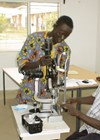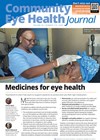History
The VISION 2020 LINK between the Sheikh Zayed Regional Eye Care Centre (SZRECC), Banjul, The Gambia and the Ophthalmology Department, Singleton Hospital, Swansea started in 2008 under the guidance of the VISION 2020 LINKS Programme at the International Centre for Eye Health, London School of Hygiene & Tropical Medicine (LSHTM). Following a scoping visit by each team to their new partner, a Memorandum of Understanding was signed and a three-year activity plan was developed together.
Aims and objectives
The Gambia-Swansea VISION 2020 LINK aims to help eliminate avoidable and treatable causes of blindness in The Gambia as part of the wider World Health Organisation (WHO) VISION 2020 initiative. Excellent leadership in the 1980s meant that The Gambia developed a model of primary eye care that has been copied across Africa. Recognition of this resulted in SZRECC being designated as an international eye training centre for four African countries as part of the Health for Peace Initiative (HFPI) – The Gambia, Senegal, Guinea Bissau and Guinea [1] and now includes Sierra Leone and Liberia. The need for ophthalmic care in The Gambia has been well studied. Around 0.7% of the population are blind and 1.4% have low vision [2]. In 80% of these people the condition is either preventable or treatable. Our LINK aims to empower local healthcare professionals and leave a sustainable legacy of developing eye care in The Gambia and the countries of the HFPI.
Early development of the LINK
Each institution (SZRECC and Singleton) established a VISION 2020 LINK Steering Group to monitor the LINK activities, to ensure that they stay on track with the agreed activity plan, and that funding is raised for training visits. Each Steering Group is made up of a mixture of professionals – medical staff, nurses, orthoptists, optometrists, pharmacists and medical engineers. A website [3] was set up to foster communication, share achievements and provide an opportunity for fundraising and awareness.
“The LINKS Programme is a very good genuine initiative that enables real skills transfer. Would highly recommend to other health institutions.”
Isatou Jobe, Optometrist, SZRECC
“The LINK has improved the level of service delivery at SZRECC with improved skills, knowledge and patient care. This has led to better skilled service providers and very satisfied patients.”
Dr Winston Ceesay, CEO and Consultant Ophthalmologist, SZRECC
The LINK is currently progressing through the second three-year activity plan. Sustainability has been central to the LINK, ensuring that changes are embedded and will continue into the future, after the LINK visits end. In most years the LINK has been able to undertake one or two visits to The Gambia with a team of four to five people, with a return visit by a similar team.
The main areas for capacity-building were identified by the Gambian team as paediatric ophthalmology and glaucoma, with emphasis on theatre, clinic and equipment maintenance. Each three-year activity plan focuses on bringing improvement in these areas – yet there have been considerable achievements which have been unplanned and likewise some activities which have been unachievable for various reasons.
At each visit to The Gambia and return visit to Swansea formal classroom teaching sessions are arranged by the eye care teams.
Sometimes case studies or audits are presented. Practical sessions in the clinic reinforce the theory learnt. For vision testing, competency standards are used and assessment sheets completed for the member of staff to have a written record of their achievements.
Achievements of the VISION 2020 LINK
Paediatric ophthalmology
The link has developed a children’s eye clinic with its own play area and accurate paediatric vision assessment. Orthoptists from Swansea have visited and taught refractionists at SZRECC how to assess children’s vision and test for a squint. Optometrists have worked with their counterparts to show them how to perform cycloplegic refraction on children. There is now a dedicated weekly paediatric clinic and child-friendly waiting area.
Paediatric cataract surgery has been introduced through the LINK. In November 2011, during a visit by the Swansea team to SZRECC, Ophthalmologist David Laws worked side-by-side with his counterpart in The Gambia, Ernest Njuwe, and together they performed 94 paediatric cataract operations to restore sight to children. Tangible outcomes like this have benefitted patients and raised staff morale.
“The Paediatric Ophthalmology service is now a reality. This was unheard of before the LINK. There is a paediatric ophthalmology triage system in place that screens and flags cases for appropriate review. A separate room has been allocated for paediatric patients. This is a huge boost but staff need encouragement as well as close monitoring to maintain delivery of a quality service.”
Dr Abba Hydara, Consultant Ophthalmologist, SZRECC

Paediatric ophthalmology waiting area at SZRECC.
Glaucoma
The Swansea team helped to train a glaucoma nurse and provided the equipment and training for accurate intraocular pressure measurement. A visual field machine was donated to SZRECC so that patients could undergo perimetry in the outpatient clinic. Repairs were undertaken to render it fully functional.
The role of the glaucoma nurse has proved to be vital in managing the large caseload of patients with glaucoma, providing patient education and cascading training. Glaucoma protocols have been adapted for local use. It is envisaged that there will be a need for more nurse practitioners in the future. As a result of this training, patients in The Gambia are able to receive glaucoma treatment before loss of sight. Patients have benefitted from the LINK because the SZRECC staff have acquired better skills and confidence to deal with their eye conditions.

Glaucoma nurse performing applanation tonometry.
In November 2013, Ophthalmologist Mike Austin was able to transfer skills in glaucoma assessment, surgical procedures and management to Dr Winston Ceesay and also train ophthalmic nurses in basic eye examination and diagnosis of glaucoma.
Equipment maintenance through the VISION 2020 LINK
Although not one of the main priorities in the original activity plan, the LINK between medical engineers in The Gambia and Swansea has been a great success. Previously, surgical services across the country were frequently interrupted for prolonged periods due to equipment breakdown. Service interruptions are now greatly reduced. During visits the two teams have shared knowledge and worked side by side to install and maintain equipment both in SZRECC and in smaller eye units in the more remote parts of the country. For instance, donated tonometers for measuring intraocular pressure were calibrated and fitted onto the slit-lamps. An autokeratometer was cleaned and restored and the lamps in theatre were adjusted to give the best light.
The introduction of a prospective equipment maintenance schedule for the whole country means that surgical microscopes, instruments and slit-lamps receive preventative maintenance. Regular email contact between medical engineers in the two countries allows support to continue between LINK visits, and a computer has been donated for a database of all eye equipment in the country.
One of the benefits of the LINK for the Swansea team has been learning how to adapt to working in an environment with limited resources.
“My first job was to fit the four tonometers, that the team had brought over, to the Zeiss slit-lamps. There were a couple of prisms missing. We checked their calibration and also the accuracy of the existing tonometer on a Haag Streit. This was found to be reading 3-4mmHg high. I recommended that we label it with the correction factor rather than attempt a repair. I do not know how to adjust these, despite my best efforts to find a solution. We also looked at the three microscopes that were in theatre. One had poor lighting because of the lamp and so I was able to repair that. The optics I could not repair properly. The top covers of the lenses on both eyepieces were missing and the lenses had fallen out. One lens spacer had gone missing. Mr Cham the SZRECC instrument technician had ingeniously manufactured top covers using drink bottle tops. I made a spacer with plastic sheet but it is not ideal.”
Paul Lawrance, Medical Engineer, Singleton Hospital, Swansea
Operating theatre standards
Training has included hand washing, sterilisation, disinfection and theatre hygiene. All theatre staff now have a Hepatitis B vaccination and are trained to manage needlestick injuries. Surgical training has taken place and nursing staff have been shown how to handle and dispose of drugs used during surgery. Anaesthetic training, with the provision of monitoring equipment, has increased the safety of paediatric anaesthesia across all surgical specialties in the country. One cataract surgeon undertook 64 cases using a safer method of local anaesthesia following training last year. The WHO safer surgery checklist is now in use. Future plans include developing the role of the scrub nurse, stock control and use of a lens bank.

Theatre staff being taught the closed glove technique at
SZRECC by Sue Williams, Theatre Sister in Swansea.
Pharmacy
Pharmacists visiting The Gambia developed the following objectives in line with the activity plan:
- Develop a production management system in order to meet eye drop demand of the hospital by the local manufacture of ocular medicines.
- Promote effective use of eye drops through introduction / improvement of patient counselling.
- Understand the supply chain and the challenges the hospital faces to meet demand for medication.
“One week was not enough time to introduce a medicines management system to improve supply of medication to patients and clinical areas within the hospital. This is the ultimate objective for SZRECC pharmacy and it will require a step-wise approach to its achievement. SZRECC is a great place and this is down to its positive, enthusiastic staff. Their willingness to change will see them improve in leaps and bounds.”
Jat Parmar, Pharmacist, Singleton Hospital, Swansea
Local football team links
In addition to the eye LINK a partnership has been established between a boys football team in The Gambia and one in Rhos, a village near Swansea. After a visit from the Swansea eye care team in 2010, the LINK team donated football kit, training gear and footballs to the Gambian / Senegalese boys.
Future plans
The LINK provides training across a wide area, working towards the provision of a comprehensive eye care service at SZRECC. Both teams will continue to follow the current activity plan which includes training in all the areas described above. In 2013, a biometer was donated to SZRECC and staff trained to use it. This will ensure that, in future, cataract patients will be able to receive an appropriate intraocular lens (IOL). Without biometry and a choice of IOLs, a significant proportion of cataract patients remain visually disabled after surgery [4]. An audit will determine the impact of biometry on visual outcomes in The Gambia.
“The introduction of biometry (best practice) will significantly improve the outcomes of cataract surgery. Over 90% of patients should have excellent vision postoperatively.”
Dr Winston Ceesay, CEO and Consultant Ophthalmologist, SZRECC
Fundraising
The eye care teams raise all the funds needed for the LINK. A range of fundraising events each year include quizzes, sponsored walks, fashion shows and charity balls. In 2013, the LINK was awarded a grant of £19,000 by the Welsh Assembly through its Wales for Africa programme [5]. All funds raised through grants, donations or fundraising events are used directly for the benefit of the LINK – for more information contact the team via the website http://www.gambia-swansea-eye-link.org/
Benefits of the LINK to the Swansea team
Staff who are involved with the LINK have benefitted greatly from the experience of working at SZRECC. It has brought together a dedicated multidisciplinary team of people, promoting teamwork and giving an insight into other roles.

A happy mother and child: a satisfied family.
Staff work in a different environment, adapt quickly and manage with limited resources. They return to Swansea with a wealth of skills which they are able to share. LINK participants are often invited to give talks to workshops and other meetings and this raises the profile of the work that the LINK is undertaking.
“Personally I have gained an insight into healthcare in The Gambia and across Africa through the LINK. I have had an opportunity to give back some of the skills learnt after working most of my life in the NHS, and had experiences that I shall always treasure.”
Stella Elliott, Link Co-Coordinator, Swansea
Summary
The LINK requires commitment in time and energy. Communication isn’t always straightforward and sometimes expectations cannot be met in the planned timeframe. Staff turnover in SZRECC has hampered some of the training. However, both teams agree that the results are rewarding and that a real difference has been, and is being, made. The bonds formed between the teams in the two different countries will ensure that the LINK will continue to go from strength to strength.
“The willingness of outsiders to help us develop our programme has had a profound impact on my world view and professional motivation. I have had the desire to train successfully as an ophthalmologist and this gained further boost from my interaction with the team visit in 2009.”
Dr Abba Hydara, Consultant Ophthalmologist, SZRECC
“The link has changed the face of ophthalmology in The Gambia. Staff have been exposed to tertiary eye care and now apprecriate the beauty of ophthalmology. This has been a major morale booster in terms of service delivery. It is a unique experience that gives the staff confidence and insight.”
Dr Winston Ceesay, CEO and Consultant Ophthalmologist, SZRECC
References
1. Sub-regional HFPI complex commissioned. Daily Observer.
http://observer.gm/africa/gambia/
article/sub-regional-hfpi-complex-commissioned
Last accessed May 2014.
2. Faal H, Minassian D, Sowa S, Foster A. National survey of blindness and low vision in The Gambia: results. Br J Ophthalmol 1989;73(2):82-7.
3. The Gambia – Swansea VISION 2020 Eye Link.
http://www.gambia-
swansea-eye-link.org/
Last accessed May 2014.
4. Imam AU, Gilbert CE, Sivasubramanian S, et al. Outcome of cataract surgery in Nigeria: visual acuity, autorefraction, and optimal intraocular lens powers - results from the Nigeria National Survey. Ophthalmology 2011;118(4):719-24.
5. Welcome to the Wales for Africa Health Links Network.
http://www.wales.nhs.uk/
sites3/home.cfm?orgid=834
Last accessed May 2014.
Case study: glaucoma in The Gambia
Mike Austin, Consultant Ophthalmologist, Singleton Hospital, Swansea.
Mr X attended SZRECC in January 2010 complaining of irritable eyes and a gradual deterioration in vision. His visual acuity was recorded as 6/9 right eye and 6/18 left eye. He had no past ophthalmic history of note and was generally well. On examination he had a small left pterygium. An incidental finding was of bilateral elevation of intraocular pressure with Goldmann applanation tonometry readings of 42mmHg right and 23mmHg left.
His optic discs showed glaucomatous cupping, the left being severely affected as evidenced by a relative afferent pupillary defect. His left visual field was shown by formal perimetry to be constricted. He was told the diagnosis and commenced on timolol eye drops. He subsequently returned to clinic for review and follow-up levels of intraocular pressure as measured by Ramatoulie Secka Danso (trained by the Swansea team as glaucoma nurse practitioner) were 34mmHg right and 24mmHg left.
Mr X returned for review by the visiting Swansea team as it was felt he might benefit from trabeculectomy. His intraocular pressures on this clinic visit were 32mmHg right eye and 30mmHg left eye. I examined him with Patricia Wade (Ophthalmologist at SZRECC) and we agreed that a left trabeculectomy would be of benefit in decreasing the likelihood of glaucoma progression, albeit in an eye with severe glaucoma and a guarded prognosis with any intervention – but certain blindness without. I was able to discuss the situation with the patient and identify for him the risks and benefits issues concerned regarding such surgical intervention. The resident doctors and Ramatoulie were able to witness this discussion, which constituted a process of informed consent.
The following day I performed a left trabeculectomy for Mr X under local anaesthetic in theatre, assisted by Sue Williams as scrub nurse, Stella Elliott as circulating nurse and Bethan Edwards as pharmacist preparing the mitomycin C for topical preoperative use. The local anaesthetic was expertly administered by Alasana, SZRECC theatre nurse. The surgery and operating theatre team working provided a teaching opportunity for the theatre workers of SZRECC, who had many appropriate questions and showed great interest in the care of the patient, the operation and the way in which we worked.
Mike Austin and Sue Williams with the glaucoma patient.
The surgery was uneventful and Mr X returned to the ward, where we were able to see him for his first postoperative dressing of the eye the following day. At this examination I was with Dr Wade, the resident doctors and ward nursing staff. His intraocular pressure in the operated eye was recorded at 17mmHg. I was able to demonstrate the postoperative examination of an eye that had undergone trabeculectomy, discuss postoperative care and the instructions for the patient.
Areas where the care of this patient demonstrates the effects of the LINKS process in patient care and continuing professional development opportunities for the whole team include:
-
techniques of patient examination
-
examination of the anterior segment of the eye
-
testing pupillary responses to light
-
demonstration of a relative afferent pupillary defect – a key physical sign
-
examination of the optic disc for features of glaucoma
-
examination of an eye prior to trabeculectomy
-
the decision-making process prior to glaucoma drainage surgery
-
the taking of informed consent
-
the technical aspects of trabeculectomy surgery
-
theatre team working
-
the roles of the scrub nurse and theatre circulating nurse
-
the maintenance of a sterile operating field
-
the preparation and use of mitomycin C in trabeculectomy, including safe disposal and staff protection issues
-
postoperative care of a patient who has had trabeculectomy
-
postoperative examination of an eye that has had trabeculectomy
-
patient education for postoperative self-care following trabeculectomy
-
continuing professional development to the members of the swansea team involved in giving this patient care and staff training
One year later when the Swansea team revisited SZRECC, Consultant Ophthalmologist David Laws (taking a break from teaching infant cataract surgery and elective anterior vitrectomy techniques) saw Mr X and was able to confirm continued good intraocular pressure control and a satisfactory trabeculectomy bleb appearance.
This is one patient’s case; similar evidence for the patient care and professional development benefits of The Gambia-Swansea VISION 2020 LINK are to be found amongst the many other patients that it has been our privilege to meet.
COMMENTS ARE WELCOME












